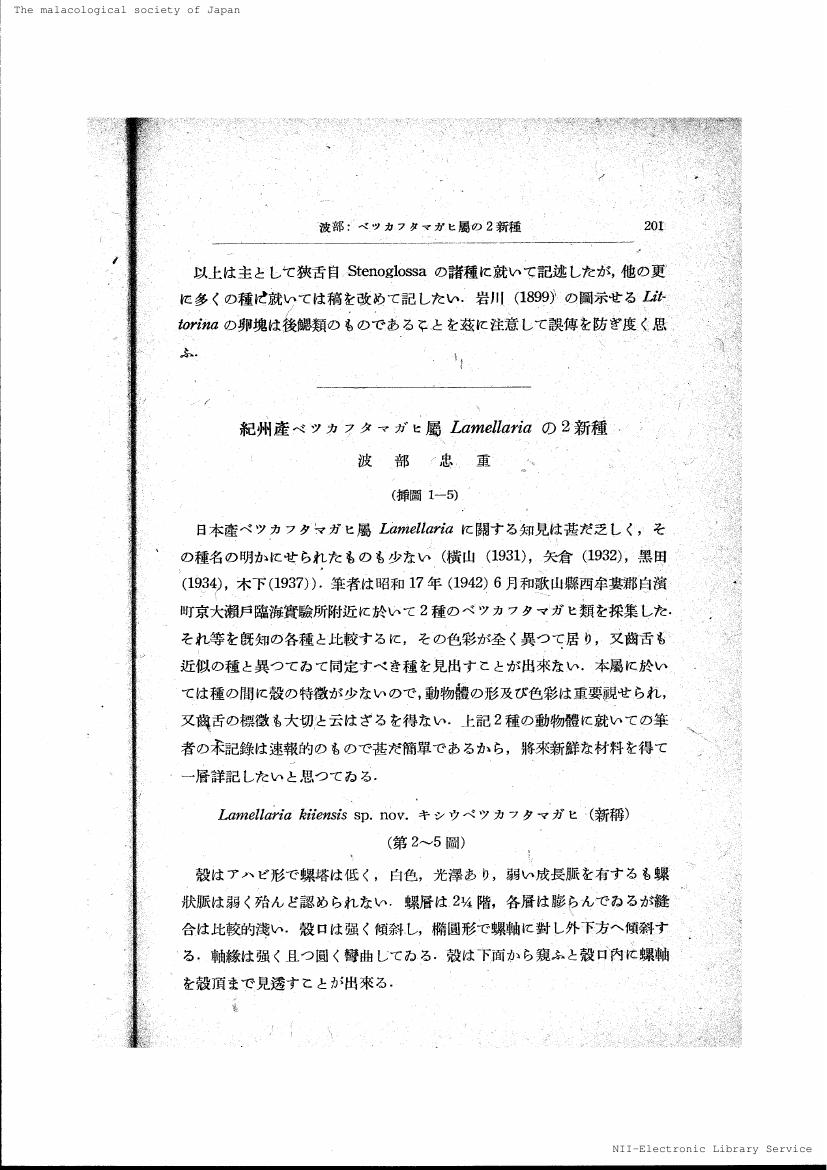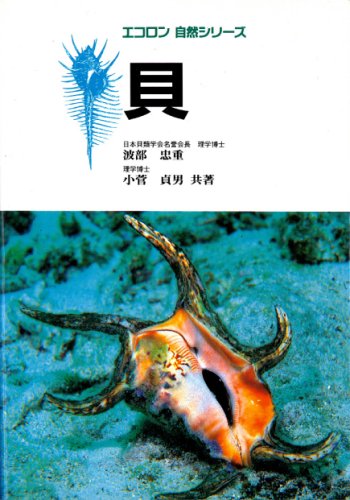6 0 0 0 OA 日本産カワコザラガイ属の 1 新種
- 著者
- 波部 忠重 バーチ ジョーン ビ
- 出版者
- The Malacological Society of Japan
- 雑誌
- 貝類学雑誌 (ISSN:00423580)
- 巻号頁・発行日
- vol.24, no.1, pp.1-7, 1965-07-31 (Released:2018-01-31)
6 0 0 0 OA 日本の洞窟並に地下水産巻貝類
- 著者
- 黒田 徳米 波部 忠重
- 出版者
- The Malacological Society of Japan
- 雑誌
- 貝類學雜誌ヴヰナス (ISSN:24330698)
- 巻号頁・発行日
- vol.19, no.3-4, pp.183-196, 1958-02-28 (Released:2018-01-31)
4 0 0 0 OA 中國地方産オホベソマイマイ屬の 2 新種並に 2 新亞種(金丸先生還暦祝賀記念號)
- 著者
- 黒田 徳米 波部 忠重
- 出版者
- 日本貝類学会
- 雑誌
- 貝類學雜誌ヴヰナス (ISSN:24330698)
- 巻号頁・発行日
- vol.16, no.5-8, pp.78-82, 1951-05-31 (Released:2018-01-31)
3 0 0 0 OA 日本産二枚貝類 4 新種
- 著者
- 波部 忠重
- 出版者
- 日本貝類学会
- 雑誌
- 貝類學雜誌ヴヰナス (ISSN:24330698)
- 巻号頁・発行日
- vol.19, no.3-4, pp.177-183, 1958-02-28 (Released:2018-01-31)
3 0 0 0 こうもりの耳殻貝
- 著者
- 波部 忠重
- 出版者
- 日本貝類学会
- 雑誌
- ちりぼたん (ISSN:05779316)
- 巻号頁・発行日
- vol.4, no.2, pp.30-31, 1966-10-25
2 0 0 0 OA 後鰓類スジナツメガイとニヨリキセワタガイの分類学上の位置
- 著者
- 北尾 耕二 波部 忠重
- 出版者
- 日本貝類学会
- 雑誌
- 貝類学雑誌 (ISSN:00423580)
- 巻号頁・発行日
- vol.41, no.1, pp.61-63, 1982-04-15 (Released:2018-01-31)
Hamineobulla kawamurai Habe, 1950 (Figs. 1-2) had been described based on only a single empty shell collected from Okinawa Main Island, Ryukyu Group, and provisionally placed in the family Bullidae. But, after Kitao's observation on radula of the specimen collected from the shallow sandy bottom off Tomioka, Amakusa, the west coast of Kyushu, it was shown that this species has no central tooth and one horn-shaped lateral tooth on each side, suggesting a close relationship with Cylichnatys angusta (Gould) of the Family Atyidae, which has one central tooth and one horn-shaped lateral tooth on each side. Therefore, Hamineobulla kawamurai Habe may be transferred from the family Bullidae to the family Atyidae. According to the original description of Pseudophiline hayashii Habe, 1976 (Figs. 3-5), this species has neither radula nor stomachal plates. But, Kitao has found the vestigial radular teeth in the buccal cavity. The radula has no central tooth, a single large lateral tooth, and two small marginal teeth on each side like in the genus Philine Ascanius, which has only a large lateral tooth on each side. Therefore, Pseudophiline hayashii Habe may be transferred from the family Aglajidae, which has neither radula nor stomachal plates, to the family Philinidae.
2 0 0 0 OA 紀州産ベツカフタマガヒ屬 Lamellaria の 2 新種
- 著者
- 波部 忠重
- 出版者
- 日本貝類学会
- 雑誌
- 貝類學雜誌 (ISSN:24330701)
- 巻号頁・発行日
- vol.13, no.5-8, pp.201-203, 1944-08-30 (Released:2018-01-31)
2 0 0 0 ジャンボタニシの学名と和名
- 著者
- 波部 忠重
- 出版者
- 日本貝類学会
- 雑誌
- ちりぼたん (ISSN:05779316)
- 巻号頁・発行日
- vol.17, no.2, pp.27-28, 1986-10-31
- 被引用文献数
- 2
- 著者
- 波部 忠重 奥谷 喬司
- 出版者
- 日本貝類学会
- 雑誌
- 貝類学雑誌Venus : the Japanese journal of malacology (ISSN:00423580)
- 巻号頁・発行日
- vol.42, no.1, pp.1-7, 1983-06-30
1 0 0 0 貝
- 著者
- 波部忠重 小菅貞男共著
- 出版者
- 保育社
- 巻号頁・発行日
- 1996
1 0 0 0 奄美大島産ノミニナ属(モクメニナ亜属)の 1 新種
- 著者
- 波部 忠重
- 出版者
- 日本貝類学会
- 雑誌
- 貝類学雑誌 (ISSN:00423580)
- 巻号頁・発行日
- vol.50, no.2, pp.95-97, 1991
A new species of the genus Zafra, Z. yukitai is distinguished from two other species, Z. divaricata Pilsbry and Z. albomarginata Okamoto & Habe in having much smaller shell ornamented with two white bands along the suture and on the periphery of the body whorl. These three species comprise a new subgenus Mokumea by peculiar ornamentation.
- 著者
- 波部 忠重
- 出版者
- 日本貝類学会
- 雑誌
- 貝類学雑誌 (ISSN:00423580)
- 巻号頁・発行日
- vol.38, no.4, 1980
1 0 0 0 コベソマイマイ 韓国に産す
- 著者
- 権 伍吉 波部 忠重
- 出版者
- 日本貝類学会
- 雑誌
- 貝類学雑誌Venus : the Japanese journal of malacology (ISSN:00423580)
- 巻号頁・発行日
- vol.38, no.4, 1980-02-29
- 著者
- 波部 忠重
- 出版者
- 日本貝類学会
- 雑誌
- ちりぼたん (ISSN:05779316)
- 巻号頁・発行日
- vol.17, no.3, 1986-12-31
- 著者
- 波部 忠重
- 出版者
- 日本貝類学会
- 雑誌
- 貝類学雑誌 (ISSN:00423580)
- 巻号頁・発行日
- vol.30, no.1, 1971
1 0 0 0 長野県木崎湖・中綱湖産ミズシタダミ科の新種キザキコミズシタダミ
- 著者
- 藤田 敬 波部 忠重
- 出版者
- 日本貝類学会
- 雑誌
- 貝類学雑誌 (ISSN:00423580)
- 巻号頁・発行日
- vol.50, no.1, pp.23-26, 1991
A valvatid snail found in the Lakes Kizaki and Nakatsuna, Nagano Prefecture, is the closest to Cincinna simusyuensis (Miyadi, 1935), but differs therefrom in having 60-65 ciliated growth lines. Thus, it is here described as a new species Cincinna kizakikoensis.
1 0 0 0 秋田県男鹿市で中国産淡水貝カワムラガイとタイワンシジミを買う
- 著者
- 西 村正 波部 忠重
- 出版者
- 日本貝類学会
- 雑誌
- ちりぼたん (ISSN:05779316)
- 巻号頁・発行日
- vol.16, no.2, pp.62-63, 1985-07-31
1 0 0 0 貝類研究採集者列伝 (70) : ハークロットとシュレーゲル Jan Adrianus Herklots (1820-1872) and Hermann Schlegel (1804-1884)
- 著者
- 波部 忠重
- 出版者
- 日本貝類学会
- 雑誌
- ちりぼたん (ISSN:05779316)
- 巻号頁・発行日
- vol.19, no.2, pp.45-46, 1988-06-30
1 0 0 0 日本におけるオウムガイ類飼育研究の進展
- 著者
- 浜田 隆士 奥谷 喬司 棚部 一成 出口 吉昭 福田 芳生 波部 忠重 平野 弘道 蟹江 康光 川本 信之 三上 進 小畠 郁生
- 出版者
- 日本貝類学会
- 雑誌
- 貝類学雑誌 (ISSN:00423580)
- 巻号頁・発行日
- vol.37, no.3, pp.131-136, 1978
Progress and some results of the second rearing experiment of Nautilus macromphalus in Tokyo are described. The temperature controlling experiment is still applying to three extant individuals, that were supplied from New Caledonia last year through the courtesy of the ORSTOM in Noumea, and they are surviving for 222 days in captivity (May 14, 1978). Copulating behaviors are observed mostly in the waters of 17-19℃ in temperature but not in the cooler conditions. Shell growth at the apertural periphery was first measured to find that some individuals probably in a gerontic stage show no remarkable increment on one hand, the young specimens show 10-12 mm elongation per 100 days on the other. Recently the JECOLN also takes care of a living Nautilus pompilius that had been floated possibly from the Philippines along the Kuroshio Current over 2, 000 km and was captured by a fishing net set off Kawajiri, Kagoshima Prefecture in Kyushu, Southwest Japan.
1 0 0 0 OA 日本産ナメクジ類の研究 (1)
- 著者
- 山口 昇 波部 忠重
- 出版者
- 日本貝類学会
- 雑誌
- 貝類學雜誌ヴヰナス (ISSN:24330698)
- 巻号頁・発行日
- vol.18, no.4, pp.234-240, 1955-12-20 (Released:2018-01-31)






